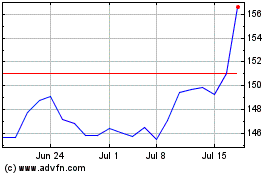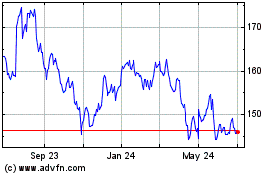By Peter Loftus
This article is being republished as part of our daily
reproduction of WSJ.com articles that also appeared in the U.S.
print edition of The Wall Street Journal (October 15, 2019).
Johnson & Johnson, facing lawsuits from more than 100,000
plaintiffs over its product safety and marketing tactics, has taken
the aggressive strategy of battling many of the cases in court.
And it is losing. A lot.
Juries and judges have ordered the health-products giant to pay
billions of dollars in several recent trials over claims that
J&J's signature baby powder and certain drugs and medical
devices injured people, and that its marketing practices fueled the
opioid-addiction epidemic.
The latest: A Philadelphia jury awarded $8 billion in punitive
damages last week to a man claiming his use of J&J's
antipsychotic Risperdal when he was a boy caused abnormal breast
enlargement. J&J has said it properly disclosed the drug's
risks and benefits, and plans to appeal the verdict.
In August, an Oklahoma judge ordered J&J to pay $572 million
to the state for contributing to the opioid-addiction crisis, a
judgment the company is appealing. Last year, a St. Louis jury
found that J&J should pay $4.7 billion to 22 women and their
families who alleged the company's baby powder caused ovarian
cancer. J&J has said the talcum powder is safe and doesn't
cause cancer; the company is appealing the decision.
The New Brunswick, N.J., company faced lawsuits from at least
103,300 people or entities in U.S. courts at the middle of this
year, up from the 8,580 plaintiffs pending in October 2011,
according to a Wall Street Journal review of J&J's securities
filings.
J&J discloses the number of plaintiffs for the most
significant of its product-liability cases in its filings.
The number of talc-lawsuit plaintiffs surged to 15,500 as of
June 30, from 1,400 in early 2016, the Journal analysis found.
Plaintiffs in personal-injury lawsuits over J&J's pelvic mesh
devices for women have declined from a peak of more than 55,000
pending in 2017 but still number about 24,800.
J&J is challenging many of the lawsuits, rather than quickly
settling, according to lawyers on both sides. "Their natural reflex
is to fight and delay, drag it out as long as they can," said Andy
Birchfield, an attorney with Beasley Allen in Montgomery, Ala., who
has sued J&J over baby powder and other products.
The Risperdal damages and some other awards are likely to be
reduced by judges, and possibly overturned, on appeal. Yet the
losses signal J&J may ultimately have to pay a costly sum to
resolve the lawsuits. The opioid litigation alone could cost
J&J $5 billion to $10 billion to settle, Wells Fargo analysts
have estimated.
J&J has won its share of trials. The company has argued
science supports the safety of its products and that its increasing
caseload is a product of aggressive plaintiffs' lawyers eyeing the
company's big pockets. It is in the company's best interest, its
outside lawyers said, to deter more lawsuits lacking merit by
avoiding premature settlements now.
J&J is approaching the litigation "with an eye to managing
this onslaught overall, and not creating false incentives for
lawyers to file even more claims that are marginal at best," said
John Beisner, a partner with Skadden, Arps, Slate, Meagher &
Flom LLP who is defending J&J in litigation over talc and some
other products.
J&J may be following in the footsteps of Merck & Co.,
which took to trial a number of lawsuits alleging its Vioxx
painkiller caused heart attacks and strokes, said Nora Freeman
Engstrom, a law professor at Stanford Law School who studies
personal-injury litigation. Merck won more verdicts than it lost
and ultimately agreed in 2007 to settle nearly all of the lawsuits
for $4.85 billion, lower than analysts initially expected. Yet a
key difference, Ms. Engstrom said, is that J&J is battling
litigation on a large scale for multiple products.
Concerns about J&J's litigation risk have weighed on its
stock, which is down 12% since its 52-week high in December,
through Monday. In comparison, over that span, the S&P 500 is
up about 10% and the index's health-care members are down 3%. Some
analysts said J&J's slide reflects investors' expectations that
J&J might have to spend from $20 billion to $50 billion to
resolve all of the litigation. J&J had $81.6 billion in revenue
last year; the company is expected to report its third-quarter
results Tuesday.
In August, Moody's Investors Service changed its outlook for
J&J's bond rating to negative from stable, citing uncertainty
over the outcome of litigation.
Attention-getting verdicts also are hurting the company's
reputation for trustworthiness, amassed from decades of careful
marketing to parents and its famous handling of a Tylenol scare.
Recent legal losses have dropped J&J to 57th out of 58
companies in a pharmaceutical reputation index developed by Alva
Group, which bases its scores on mentions in the news, social media
and analyst reports. J&J was in the index's top 10 in 2014.
A J&J spokesman said the company's reputation remains strong
because it has developed high-quality consumer products and
treatments for cancer and HIV. He said the company's victories at
trial and reversals of losses on appeal don't garner the same level
of attention as high-dollar trial losses.
The company's wins include two talc trials last week in which
California juries sided with the company. And it has settled
others.
In March, J&J and partner Bayer AG said they agreed to pay
$775 million to resolve most claims that their blood thinner
Xarelto causes excessive bleeding. The companies had won several
Xarelto trials and didn't admit liability in the settlement. This
month, J&J agreed to pay $20.4 million to settle opioid
lawsuits filed by two Ohio counties, avoiding a trial.
Some lawyers said the longer litigation continues, the easier
the cases become for plaintiffs to win because more documentation
is unearthed and plaintiffs' lawyers can refine their strategies
based on earlier trials.
"The cases only get better for plaintiffs, not worse," said
Richard Golomb, a Philadelphia attorney representing women who have
sued over J&J's baby powder.
J&J, however, has a reason for holding out on a large talc
settlement. It has asked a federal judge in New Jersey overseeing
pretrial proceedings for a majority of the talc suits to exclude
testimony from the plaintiffs' expert witnesses who claim talc
causes cancer. Plaintiffs' lawyers said the testimony should be
allowed.
If the judge sides with J&J, it could effectively wipe out
most of the talc lawsuits; a decision is expected in the coming
months.
Write to Peter Loftus at peter.loftus@wsj.com
(END) Dow Jones Newswires
October 15, 2019 02:47 ET (06:47 GMT)
Copyright (c) 2019 Dow Jones & Company, Inc.
Johnson and Johnson (NYSE:JNJ)
Historical Stock Chart
From Mar 2024 to Apr 2024

Johnson and Johnson (NYSE:JNJ)
Historical Stock Chart
From Apr 2023 to Apr 2024
